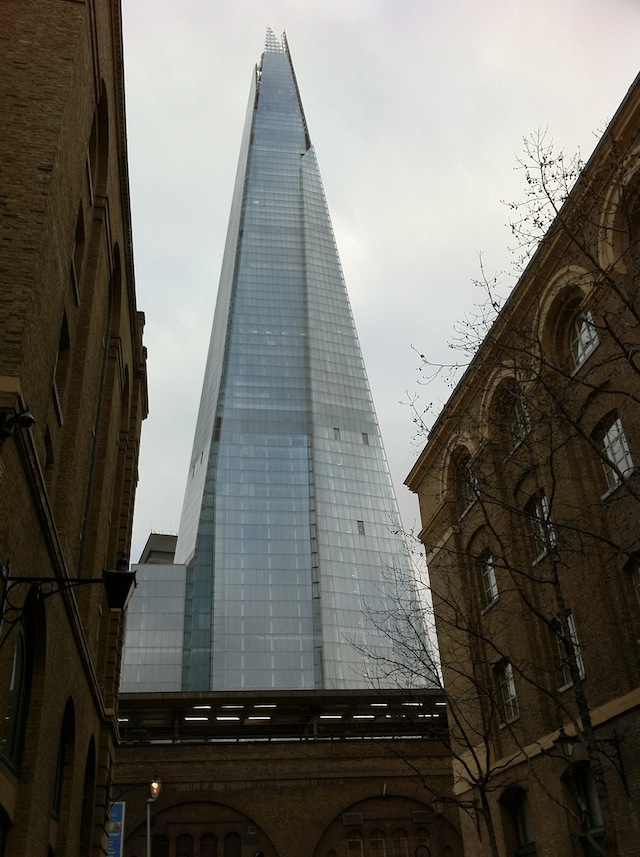Why does the Shard intimidate us?
@sssukiii | Monday 16 April, 2012 14:38

Optimism, shock and awe
When the tired, pollution stained Southwark Towers was demolished by a 100,000 lb wrecking ball and workmen started laying the foundations for Renzo Piano’s Shard of Glass in 2008, many Southwark residents felt a surge of optimism on seeing the image of Europe’s tallest building, half a kilometre from their doorsteps.
Over the last four years that optimism has alternated with architectural pride, a forced and tested trust in technology, incomprehension of its scale, a sense of material inequality, awe, not to mention momentary paralysing vertigo.
The bold, simple and futuristic lines of the building championed London as the home of cutting-edge design: especially as it embodied architectural values which Britain has historically shied away from. It marked a possible paradigm shift.
Some environmentalists and most urban planners also champion it for encouraging vertical development, which reduces urban sprawl and reduces the resources, needed to transport consumers to out-of-town business parks.
Gusty winds and vertigo
Towards the end of 2010, St Thomas’ Street, at the foot of the tower, had noticeably been transformed into a virtual wind funnel. Awe alternated with nervousness as local workers contemplated 5-ton concrete crane counterweights suspended above their heads, whilst rushing to work.
Anyone looking closer would have noticed that the cranes themselves were clamped onto the sides of the Shard, stretching our trust in the construction sectors capacity to innovate, literally to new heights.
As gale force winds blew grown men over in January 2012, construction was paused. Even then, the Shard was terrifying against the freezing winter sky, reflecting the surrounding electric glows and twinkles, like the Terminator’s sunglasses.
As I introduced it to my five-foot tall mum, I was reminded of the hobbits beholding Mount Doom. Personally, I couldn’t look at the tower without feeling a bit sick and easy to crush. I felt some relief when the rain gave me an excuse to put my umbrella up, like a shield against its looming presence.
Appreciable from a distance
In Spring 2012 construction of the outer shell of the building draws to a close. Londoners may take pride in the Shard from the many vistas it commands around South East London. From here the full shape and effect of the development can be appreciated.
As the London region is the shape of a bowl, the Shard easily stands out from outer London boroughs, as far away as Harrow-on-the-Hill, 50 kilometres away in West London. Here it pinpoints London Bridge Station like a Monopoly piece. At night, from the warren-like side streets of Elephant and Castle, it functions as a helpful Northern Star.
Bolstering London’s two-tier housing market
However, the idea of the tower growing, like a column of bar chart indicating the level of economic regeneration to the London Bridge area, now seems more far fetched. As the upper floors of Europe’s tallest building are transformed into world-class hotel suites and pent houses, Southwark will now become one of the worlds most unequal neighborhoods for house prices.
Homes in the Shard are forecast to sell for £30 to £50 million each, demonstrating that the development is more likely to bolster the gulf between London’s two-tier housing market, for the foreseeable future, rather than bring tangible benefits to the local community. Unless partnerships are organised to develop supply-chains with local businesses the tower risks becoming an isolated bubble of wealth.
Material inequality, which one aspect of the Shard represents, may be tastefully out of sight so many floors above us. As it looks down its nose at us, how can this inequality not be tangibly sensed, when the building which contains it so jarringly reminds those at its base how tiny we are?
Follow this writer at @sssukiii
Snipe Highlights
Some popular articles from past years
- The five best places in London to have an epiphany
- Silencing the Brick Lane curry touts could be fatal for the city's self-esteem
- Only 16 commuters touch in to Emirates Air Line, figures reveal
- The five spookiest abandoned London hospitals
- Peter Bayley has worked for 50 years as a cinema projectionist in East Finchley
- Punk brewery just as sexist and homophobic as the industry they rail against
- An interview with Desiree Akhavan
- Summer Camp: Roll out those lazy, hazy, crazy days
- Margaret Thatcher statue rejected by public
- A unique collection of photos of Edwardian Londoners
© 2009-2025 Snipe London.
